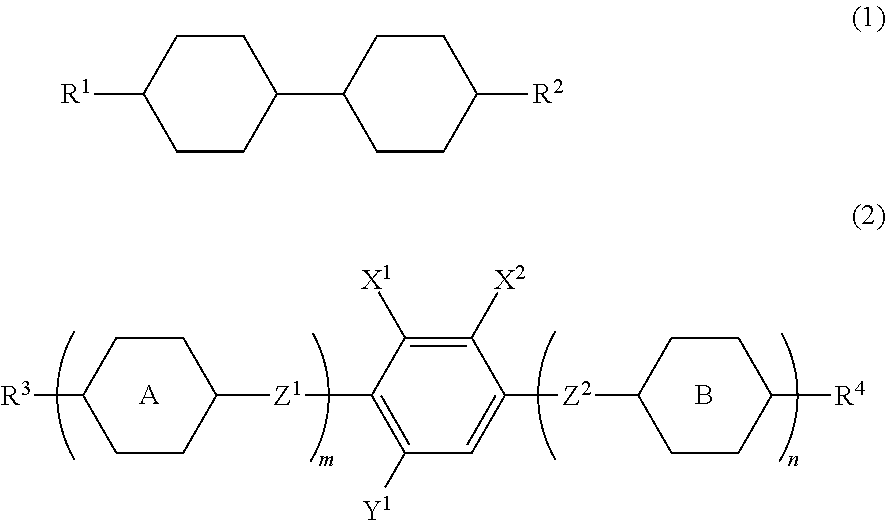Liquid crystal composition and liquid crystal display device
a technology of liquid crystal composition and display device, which is applied in the direction of instruments, organic chemistry, transportation and packaging, etc., can solve the problems of long service life of devices, and achieve the effects of small viscosity, high UV light stability, and large specific resistan
- Summary
- Abstract
- Description
- Claims
- Application Information
AI Technical Summary
Benefits of technology
Problems solved by technology
Method used
Image
Examples
example 1
[0101]Among types of compound (1-1-1), the following compound was prepared.
[0102]1H-NMR (CDCl3; δ ppm): 5.77 (ddd, 1H, J=17 Hz, 10.5 Hz, 6.5 Hz), 4.95 (ddd, 1H, J=17 Hz, 1.5 Hz, 1.5 Hz), 4.87 (ddd, 1H, J=11 Hz, 1.5 Hz, 1.5 Hz), 4.42 (dt, 2H, J=47.5 Hz, 6.2 Hz), 1.92-1.82 (m, 1H), 1.78-1.64 (m, 10H), 1.28-1.24 (m, 2H), 1.21-1.12 (m, 1H), 1.10-0.84 (m, 10H); 19F-NMR (CDCl3; δ ppm): −218.0 (tt, 1F, J=95.0 Hz, 23.8 Hz).
[0103]Phase transition temperature was Cr 3.0 SB 36.0 N 53.4 Iso. Herein, Cr, SB, N and Iso stand for a crystal, a smectic B phase, a nematic phase and an isotropic liquid, respectively, and all of units of the phase transition temperature were ° C. Moreover, the compound was mixed with mother liquid crystals and values of characteristics of the compound were determined by an extrapolation method. NI=33.9° C.; Δ∈=−1.0; Δn=0.039.
example 2
[0104]Among types of compound (1-1-1), the following compound was prepared.
[0105]1H-NMR (CDCl3; δ ppm): 5.77 (ddd, 1H, J=17 Hz, 10.5 Hz, 6.5 Hz), 4.95 (ddd, 1H, J=17 Hz, 1.5 Hz, 1.5 Hz), 4.87 (ddd, 1H, J=10.5 Hz, 1.5 Hz, 1.5 Hz), 4.49 (dt, 2H, J=47.5 Hz, 6.2 Hz), 1.92-1.83 (m, 1H), 1.80-1.71 (m, 8H), 1.58 (ddt, 2H, J=26 Hz, 6.5 Hz, 6.2 Hz), 1.41-1.33 (m, 1H), 1.10-0.89 (m, 10H); 19F-NMR (CDCl3; δ ppm): −218.3 (tt, 1F, J=47.5 Hz, 52.9 Hz).
[0106]Phase transition temperature was Cr −26.2 SB 41.4 Iso. Herein, Cr, SB and Iso stand for a crystal, a smectic B phase and an isotropic liquid, respectively, and all of units of the phase transition temperature were ° C. Moreover, the compound was mixed with mother liquid crystals and values of characteristics of the compound were determined by an extrapolation method. NI=15.0° C.; Δ∈=−0.6; Δn=0.024.
example 3
[0107]Among types of compound (1-1-1), the following compound was prepared.
[0108]1H-NMR (CDCl3; δ ppm): 5.41-5.33 (m, 2H), 4.42 (dt, 2H, J=47.4 Hz, J=6.3 Hz), 1.80-1.66 (m, 11H), 1.63 (d, 3H, J=4.1 Hz), 1.28-1.23 (m, 2H), 1.20-1.11 (m, 1H), 1.06-0.83 (m, 10H). 19F-NMR (CDCl3; δ ppm) −218.05 (dt, 1F, J=47.4 Hz, J=24.4 Hz).
[0109]Phase transition temperature was Cr 43.6 SB 49.8 N 87.2 Iso. Herein, Cr, SB, N and Iso stand for a crystal, a smectic B phase, nematic phase and an isotropic liquid, respectively, and all of units of the phase transition temperature were ° C. Moreover, the compound was mixed with mother liquid crystals and values of characteristics of the compound were determined by an extrapolation method. NI=77.0° C.; Δ∈=−2.6; Δn=0.064.
PUM
| Property | Measurement | Unit |
|---|---|---|
| temperature | aaaaa | aaaaa |
| temperature | aaaaa | aaaaa |
| frequency | aaaaa | aaaaa |
Abstract
Description
Claims
Application Information
 Login to View More
Login to View More - R&D
- Intellectual Property
- Life Sciences
- Materials
- Tech Scout
- Unparalleled Data Quality
- Higher Quality Content
- 60% Fewer Hallucinations
Browse by: Latest US Patents, China's latest patents, Technical Efficacy Thesaurus, Application Domain, Technology Topic, Popular Technical Reports.
© 2025 PatSnap. All rights reserved.Legal|Privacy policy|Modern Slavery Act Transparency Statement|Sitemap|About US| Contact US: help@patsnap.com



